Introduction:

Over the past few years, three bridges in Cork have received much media focus – St Patrick’s Bridge and its cleaning and restructuring, the new Mary Elmes Bridge and its modern design and thirdly Daly’s Bridge, AKA the Shaky Bridge and its mass cleaning and re-strengthening programme. Such work was spearheaded by Cork City Council.
Perhaps of the three bridges that I have listed the last one, Daly’s Bridge, opened in 1927, is one which holds the fascination of the public the most. The removal of the main body of the bridge to de-clean it off site caused a large tinge of public sadness. Its return to the banks of the River Lee in the spring of 2020 heralded hope and almost the sense of a valued family member had returned.
The bridge’s essence has transcended time from a physical bridging point to one of playfulness, one of fun and one whose shakiness is a key part of Cork’s cultural heritage. This brief history is an attempt to shine a light on the most honoured of Cork City Bridges.
View: “The bridge that must legally wobble” with Tom Scott and an interview with Kieran McCarthy
VIEW: A talk about The History & Rehabilitation of Daly’s (Shakey) Bridge, Cork City by Kieran McCarthy and Michael Minehane: https://youtu.be/j52poh2ZfSA
A Ferry Crossing:
For years before the age of Daly’s Bridge, there was a ferry crossing across the river. The importance of the ferry to residents in Sunday’s Well was immense especially to have access to the beautiful tree-lined Mardyke Walk. As time progressed, the ferry rights across the River Lee to the market were passed down from the Weber family to the Carlton family and then came to the Dooley family.
Indeed, in August 1824, it is recorded in the Cork Constitution newspaper that John Dooley of the Ferry Walk Sunday’s Well claimed compensation in consequence of the new Wellington Bridge to be built near the western end of the Mardyke (the present Thomas Davis Bridge). He claimed that his ferry rights would be injured. He had held the ferry for many years, but on cross-examination he admitted that he had no exclusive rights. He was granted £10 for his claim.
By the mid-nineteenth century, the northern suburbs of Sunday’s Well and Shanakiel were well established, with large villas and terraces of houses taking advantage of the sloping sites with their views of the river and the Mardyke to the south. By the time of the 1842 Ordnance Survey map, the sloping path from Sunday’s Well Road down to the ferry crossing point had been set out, and the long, straight Ferry Walk on the southern side brought the ferry’s passengers to the Mardyke walk.
There is a house indicated at the end of the path from Sunday’s Well, visible as a structure to the north eastern bank of the river. On the large scale OS map surveyed on 1869, the house on the north-eastern bank of the river at the ferry crossing is depicted as a substantial structure.
The approaches to the crossing from both North and South are on the same routes as the present approaches to the bridge. The beautifully set out gardens of Charles Beamish’s recently constructed house, ‘The Shrubberies’, are shown on the site of the present Fitzgerald’s Park. UCC’s sports grounds had not been developed at this stage, but the tree-lined Mardyke Walk, which had been laid out in 1719, was popular as a place for walking and recreation.

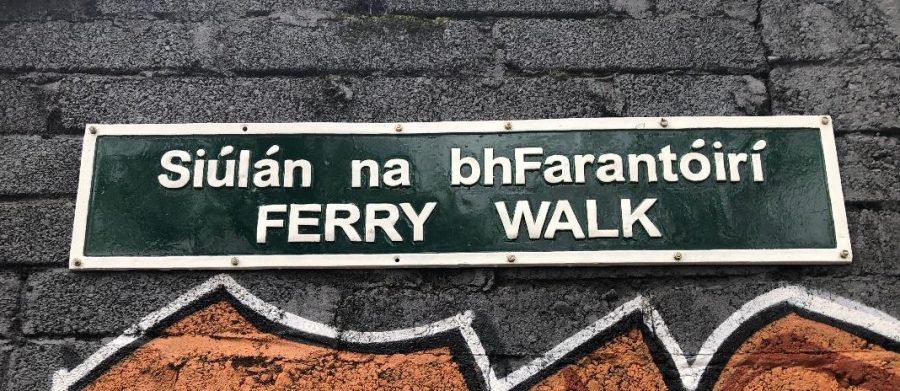
The Ferry Crossing Site, 1890:
A photograph from the Lawrence Collection provides a clear image of the Ferry crossing. The main photographer, with the exception of studio portraits, for the firm of William Lawrence from the late 1870s to 1914 was Dublin man Robert French. He took at least 40,000 photographs over approximately thirty years. During that time railways criss-crossed the land. The William Lawrence firm developed photographic sets covering each city, county and beauty spot, portraits of priests, prelates and politicians, churches, jails and prisons, scenes of Irish life and character, and comic sketches of Irish life and character. They came in albums, as magic lantern slides, and stereoscopic views. There were postcards by the thousands. Most of them were hand-coloured as were the other views which came in elaborate frames.
The ferry crossing photograph is undated, it is certain that it was taken later than 1879, when St. Mary’s Church on Shanakiel Road, the spire of which is visible in the background of the photograph, was completed. The house is a substantial one, and although it is no longer standing, there are likely to be some remains of its walls surviving on the site, which is now heavily overgrown. On the opposite bank of the river, a structure is indicated on the 1869 map on the site of the present limestone steps to the river, below Daly’s Bridge.

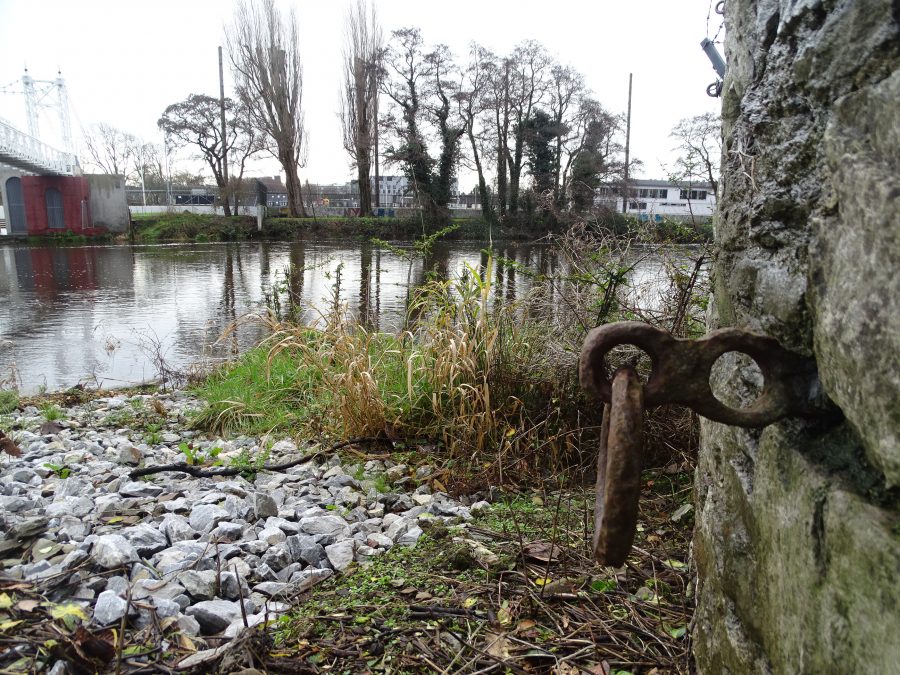
Boating at the Mardyke, 1899:
The Dooley family did not have the river Lee to themselves. By the closing years of the nineteenth century boating on the Lee adjacent the Mardyke was a popular pursuit. Hence Sunday’s Well Boating and Tennis Club was founded in 1899, shortly after a successful July “Sunday’s Well Regatta and Water Carnival” had been held on the Lee. The Club was formed by some of the regatta committee organisers, who were boating and tennis enthusiasts from the locality.
The committee then leased a plot of ground off the Mardyke Walk alongside the river and that is the ground which the Club occupies today. It was uniquely linked with the Cork International Exhibition of 1902/03, principally because it lent its grounds to the Exhibition, and the present clubhouse was built by the Exhibition Committee for visiting dignitaries, which included King Edward VII and Queen Alexandra. In 1904, the Club took possession of the clubhouse. Sunday’s Well had, in addition to its magnificent new clubhouse, five excellently laid out and perfectly manicured grass courts.

The Great Chute & the Cork International Exhibition, 1902-1903:
From May to November 1902, Cork City played host to one of the most significant events in its entire history – the International Exhibition of Manufactures, Arts, Products and Industries. It spanned a 44-acre site not far from the city centre encompassing an area on the Mardyke that now includes the Cork Cricket Club, the Sunday’s Well Boating and Tennis Club, Fitzgerald Park, and University’s Sports Arena. The exhibition grounds were elaborately laid out and had several large exhibiting halls and pavilions as well as an assortment of smaller buildings including tea houses, restaurants and kiosks. Irish and foreign exhibitors, some from ‘exotic’ locations such as China, Russia, and Turkey, filled these halls and pavilions with exhibits and demonstrations for all to see. The exhibition was visited by over a million people.
There was plenty entertainment on offer for the visitor. Licensed refreshment restaurants were scattered through the grounds and gardens. The Temperance Restaurant was situated close to the Water Chute. Ample floor space was provided, and the restaurant was supplied with refreshments of the best quality. Tea houses were conveniently situated throughout the gardens and also in the western field.
Sports of all kinds took place on the Sports Grounds, where a ‘grand stand’ was provided. The sports included athletic and bicycle contests, lawn tennis tournaments, crickets and other minor sports. On the River Lee, which flowed beside the Exhibition Gardens, electric launches, gondolas, and ferries frequently plyed, and “afforded a pleasant change to those who desired to view the grounds from the water”. On the other side of the River were the pretty gardens of Sunday’s Well. Gondolas were steered by Venetian boatmen, who entertain the passengers by singing songs of Ireland.
The Great Water Chute was close to the Industrial Hall, and measured seventy feet in height, and lay adjacent to the ferry crossing. Cars carried passengers up a gradual ascent to the summit, when a seat was taken in one of the boats, which then started down the incline, hitting the water at speed.
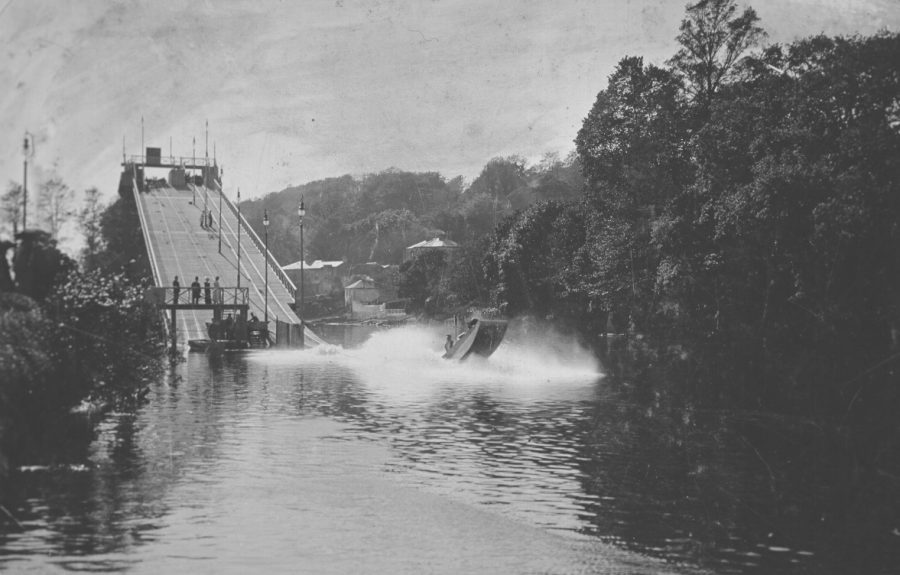
Creating Fitzgerald’s Park, 1906:
At the end of the Cork International Exhibition in 1903 in the Mardyke, the organisers wished to give the grounds to the people of Cork as a place of recreation.
A decision was taken to name the new public space after Edward Fitzgerald, the organiser of the Exhibition and Lord Mayor of Cork from 1901 to 1903. This was to be a group who would promote and provide funding for band recitals and ‘water carnivals’ and the upkeep of the park. The park would always be free to the public but the Committee reserved the right to change six-penny admission fee during a certain time in the year. This was to defray the cost of landscaping the park, a cost of £400 a year.
A general Park Committee was agreed upon and established by the Exhibition committee. By the end of 1903, the Committee took a decision to buy an additional five acres of land, which fronted the Mardyke and Ferry Walk from Captain Jennings for £1,250.
Two years passed and in 1905 the Park Committee were deemed ineffective by their peers. In March 1906, it was agreed to vest the Park and the Shrubberies House in the Corporation with the provision that the Corporation would levy a rate of a half –penny in the pound through municipal taxation for the annual up-keep of and maintenance. A further provision provided that the Shrubberies House be turned into a municipal Museum. The Corporation willingly accepted the gift on behalf of the citizens and embarked on a scheme of improving, landscaping and extending the grounds.

The Creation of a Rugby Pitch, Mardyke 1904:
At the end of 1901, John Reese of Cork Rugby Football Club noted his intention, as Chairman of the Munster Branch of the Irish Rugby Union, to pursue the idea of having a Rugby International, played in Cork during the Exhibition Year of 1902. The Wales team were due to come to Cork the following March, but the game did not occur. The Rugby Union were supposed to finance the erection of stands but the plan did not materialise. Another idea proposed was that the game might be played at Cork Constitution, who were based near the Lough. Eventually, the game was played at Lansdowne Road.
However, John Reese pursued his idea after the 1903 Exhibition. In February 1904, the lease of the Exhibition Committee with Captain Jennings expired. Reese together with former Mayor, P.H. Meade and F.D. Morrogh, as fellow trustees secured a lease of the Western Field. They gave the operation of the grounds as a rugby venue to both Cork County and Cork Constitution Rugby clubs. Reese also bough the wire fencing around the Western Field for £200 and the Chalet Restaurant, one of the finer timber buildings of the Exhibition for £350. The Restaurant was demolished and the timbers were used in building a rugby pavilion in the new grounds.
Finance was raised and before the start of the 1904 /1905 Rugby season, £1,400 had been spent on the nineteen acres to transform it into one of the finest pitches in Ireland. The grounds and were officially opened on Saturday, 24 September 1904 by Lord Mayor, Augustine Roche.
One last remaining feature of the International Exhibition, which lay untouched for several years after the event, and which was an eyesore surrounding the Rugby Pitch was the Exhibition enclosure. Corporation councillors voiced numerous complaints on its deteriorating condition. A deputation of residents from Sundays Well noted to the Corporation that the enclosure hid the panorama of Shanakiel with its gardens and woods. In addition, the residents debated that many people could see the games from the height of Shanakiel.
The Irish Rugby Union and Professor C.W.C. Alexander, Chairman of the Cork Football Grounds Committee argued that they would have to spend (£600) to take it down and hence some international games could not funded the following years. However, public pressure led to the dismantlement of the wall in 1910 under the direction of the latter Rugby Committees. A new canvas wall was manufactured that was put up for the duration of games. However, in 1925, Commissioner Monahan of Cork Corporation ordered the erection by UCC of railings around the Rugby Field.

Local Residents and a Bridge Proposal, 1908:
With the development of Fitzgerald’s Park and the Rugby Grounds, the ferry crossing that had formed a route from Sunday’s Well to Shanakiel came under increasing pressure. Although Wellington Bridge had been built a short distance to the west in 1830, suggestions by local residents in Sunday’s Well noted that a footbridge would better serve the ferry route.
On 28 August 1908 a deputation of residents of Sunday’s Well consisting of Messes P Murphy, M J Stapleton, M P Bolster, H Dawson, P W Shea, Coroner A Blake, appeared before the members of Cork Corporation. Coroner Blake acted as spokesman, and said he appeared accompanied by the other gentlemen, on behalf of the residents of Sunday’s Well, for the purposes of bringing before the Corporation of Cork a matter that they considered of some importance.
Coroner Blake had got a recent letter during that week from Mr Thomas Dooley, proprietor of the ferry at Ferry Walk, stated that due to impending retirement he was willing to sell his interest in it to the Corporation for £100, if they sought to purchase it. Since receiving the letter, he had consulted some of the Residents of Sunday’s Well, and wished to bring some observations before the Corporation of Cork.
Coroner Blake outlined that Corporation had been, as far he knew were owners and proprietors of most of the ferries in the city of Cork, and if they bought the rights to the ferry in question it would be, he believed, be an “advantage to the citizens at large”. If the Council thought the proposal a proper one, he suggested that instead of a ferry, a suspension bridge could be erected. He had taken the trouble to look up the matter as to the cost of such a bridge and found that one could be erected – four feet-wide at a cost of £140.
Coroner Blake outlined that it was only one means of communication between St Vincent’s Bridge and Wellington Bridge, otherwise there was no means of communication between the north and south of Cork.
“On the north side were Sunday’s Well, Janemount and Blarney street, a large district with a great population. If they wanted to get across the city the only way available for them was to go around by St Vincent’s Bridge, a circuitous route, or Wellington Bridge also a circuitous route. The people of Sunday’s Well represented a great deal of the rates of the city. They contributed a large proportion of them; they did not want a large expenditure and didn’t think it an unreasonable sum to ask the Council to expend in purchasing the ferry or adopting the other suggestion of the suspension bridge”.
Sir Edward Fitzgerald, Councillor and the Chairman of the meeting, said he believed that the bridge proposal was a necessity. The matter was then referred to the Public Works Committee.

Consideration at the Public Works Committee, September 1908:
On 1 September 1908, the proposed Ferry Walk Bridge was discussed at the Public Works Committee. Sir Edward Fitzgerald Councillor, said the first thing to be done was to instruct the Engineer to supply the Committee, at his earliest convenience with the cost of a suspension bridge.The next question was that of buying the rights of the ferryman .
Sir Edward Fitzgerald was in favour of having the bridge built, but he thought that idea would be by far the more expeditious. He stated that there were three or four ferry related people. Some of them he thought might be in America, and he did not want the Council to be in the position to have claims coming in from various people.
Sir Fitzgerald moved that the Engineer explore what type of bridge could be constructed,
The motion was passed unanimously.

Public Works Committee Meeting, Extract from Cork Examiner, 2 September 1908 (source: Cork City Library)
A Community Responds, November 1908:
On 5 November 1908, a meeting of the residents of Sunday’s Well and district was held in the Shanakiel Schools to consider the perspective of the Public Works Committee and the idea of the neighbourhood a subscription towards the bridge. Coroner Blake noted that he had not the slightest objection to subscribe, nor did he think it was unreasonable that he or any resident of Sunday’s Well should be called upon to do so.
Coroner Blake was sure the whole thing could be done well for from £300 to £400, and if the money was borrowed from the Local Government Board for a period of from 33 to 35 years it would not come to £20 a year to pay off the wholeamount of it. He would suggest that after that meeting they should leave the matter in the hands of their public representatives in the Corporation.
Mr Michael Egan, JP, Councillor, said he considered it was unfair , unjust and unreasonable for the Corporation to ask any private resident in Sunday’s Well to contribute £100 for the purchase of the ferry rights considering that a number of people would benefit as much by a bridge as the residents of Sunday’s Well. He happened to be present at the Council meeting on the day that the deputation came before the meeting, and the then chairman Sir Edward Fitzgerald stated that he considered £500 would not be at all too much to put up a respectable bridge across the river.
Local Resident Mr Stapleton then proposed a resolution calling on the Corporation to purchase the ferry rights and to spend such a sum of money for the building of a bridge as in the opinion of the City Engineer would be necessary. As regards contributing money they would be all willing to do so, but it would be bad principle to adopt. Mr James Daly, JP, seconded the resolution, which was adopted unanimously.

Public Works Committee, 25 April 1910:
In April 1910, the City Engineer, Mr Delaney, gave particulars regards the site and the approaches to the bridge and a general discussion took place on the question of the situation and character of the new bridge. A suggestion for an alternative position further down the river came under consideration but finally it was agreed that the City Engineer should report fully on the subject, and the report would be discussed at the next meeting of the Public Works Committee. Ultimately though the item fell off the agenda due to cost and was not discussed again for over a decade by members of Cork Corporation.
The 1922 Analysis:
Fast forward to 5 February 1922 and an update at the Corporation of Cork’s Fitzgerald’s Park Committee reveals ongoing lobbying for the suspension bridge. The chairman noted a gentleman living in the locality had attained the Sunday’s Well Ferry Site on a lease for 999 years at a shilling a year. He was informed that the gentleman referred to would make a present of it to the Corporation for the purpose of building a bridge across the Lee at the Ferry Walk. It would cost the Corporation nothing for the acquisition of land there, as they would given it for free for the purposes of building the bridge and for a period of 999 years. The recommendation was to be sent to Council for further discussion.
On 5 May 1922, the Committee proceeded to consider a reference from the Public Works Committee following City Engineer’s sketch of proposed bridge over the Lee at the Ferry Walk crossing. The cost he estimated was at between £5,700 and £4,000. The Chairman, Cllr John Good, noted of the bridge proposal that the “money kills it”. He suggested that the matter then be adjourned for a time.
Mr James Daly’s Intervention, 1926:

In 1926, the
substantial financial contribution of Sunday’s Well resident James Daly eventually broke the deadlock on funding the suspension bridge project. Born at Moycollop, County Waterford in 1856, James Daly (1856-1942) began his business life in his native district as a butter and egg merchant. At an early age founded and was managing director, of the firm of James Daly and Sons, Ltd., which had bases om Cork’s Shandon Street, Dominick Street, and Mulgrave Road. James was one of Cork’s most enterprising and successful Corkonians. His association with the butter industry extended over half a century from the 1880s to the early 1930s.
Under his own personal supervision James merited for his firm a world-wide reputation and employed many peoople. In addition to the butter industry, the firm were also proprietors of the Shandon Castle Margarine Factory, which was established until 1905, and erected on the site of the ancient Shandon Castle. He was one of the trustees of the Cork Butter Exchange.
As an agriculturalist, James was well known throughout Cork and Waterford, being the owner of large farms in each of these counties. He also possessed extensive fishing preserves on the River Blackwater, and game preserves in the same vicinity.
James was also a Justice of the Peace, a member of the Cork Chamber of Commerce, and a member of the National Liberal Club of London.
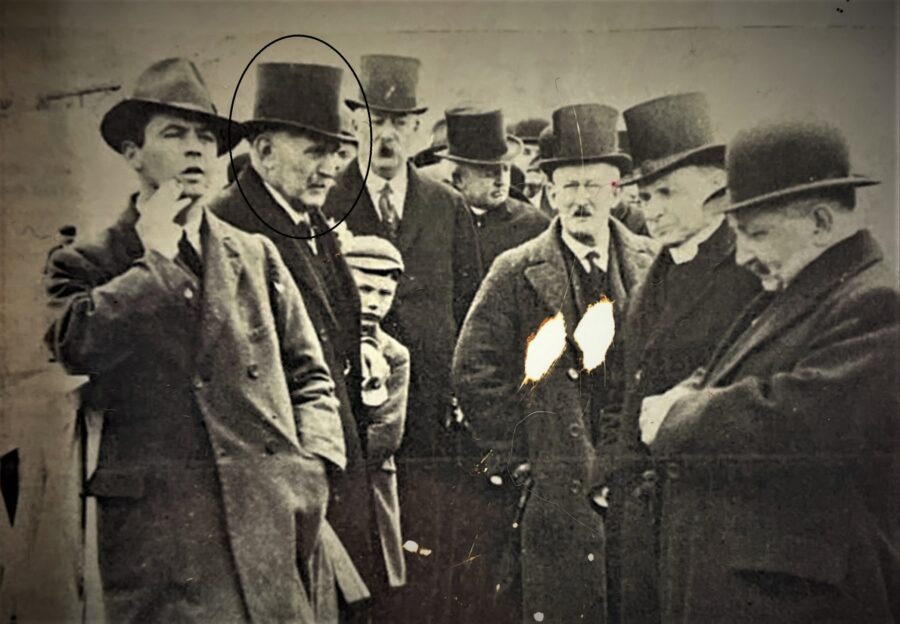
Stephen Farrington, City Engineer:
The work of Stephen Farrington (1889-1965), City Engineer, is mentioned alot as a leading light in working with James Daly in the realisation of a new bridge. Born in Cork City circa 1889, Stephen came from a distinguished Cork Presbyterian family. He studied at Cork University, where he obtained BA and ME degrees. After graduating he worked for a time in Northern Ireland, first with Belfast Corporation, then with the Belfast & Co. Down Railway, and finally as town surveyor of Lisburn, County Antrim. In 1924 he was appointed city engineer of Cork, a post which he held until his retirement in 1958.
Stephen was a right hand man to Cork City Commissioner Philip Monahan for four decades overseeing and engineering in particular the design of the new suburban local authority housing schemes, replacing the city’s aging eighteenth century culverts, a new water municipal filtration scheme, and the Lee Baths – to name just a few of his activities.
For many years Stephen lectured on municipal engineering at University College, Cork. A fluent speaker of Irish and French, he was an active member the Cork Literary and Scientific Society. He was also a keen sportsman, which in part also probably influenced the creation of the Lee Baths.
The Bridge Catalogue of David Rowell & Company, 1927:
The decision was made by Stephen Farrington that the new bridge should be a steel suspension bridge, a type popular in the early decades of the twentieth century, though few were built in Ireland.
The decision was made to purchase a bridge from the English bridge manufacturers David Rowell & Company. The company was established in London in 1855, initially manufacturing iron fencing, but diversifying into structural steel and bridges. They developed an international reputation for their steel suspension bridges, building a great number of bridges between 1903 and 1951, before the closure of the company in 1970.
The catalogues provided by David Rowell & Company show that Daly’s Bridge closely resembles some of their standard designs, with some changes including the pointed finials above the towers at either end. It appears to be fairly narrow in comparison with some of their standard foot bridges.
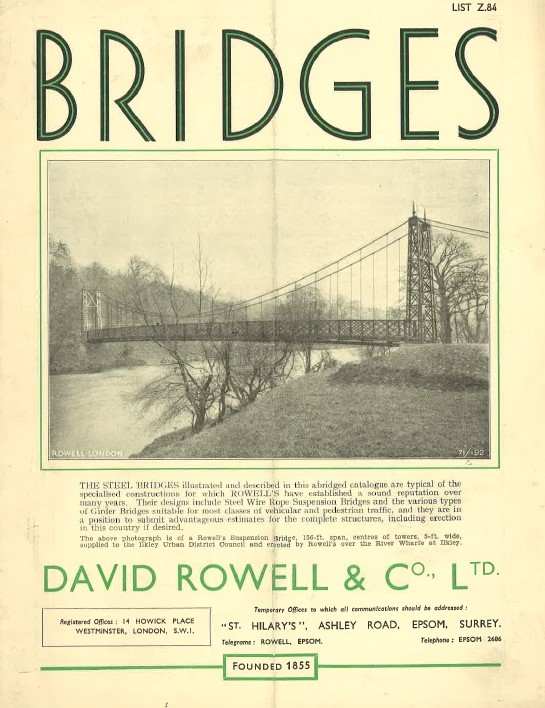

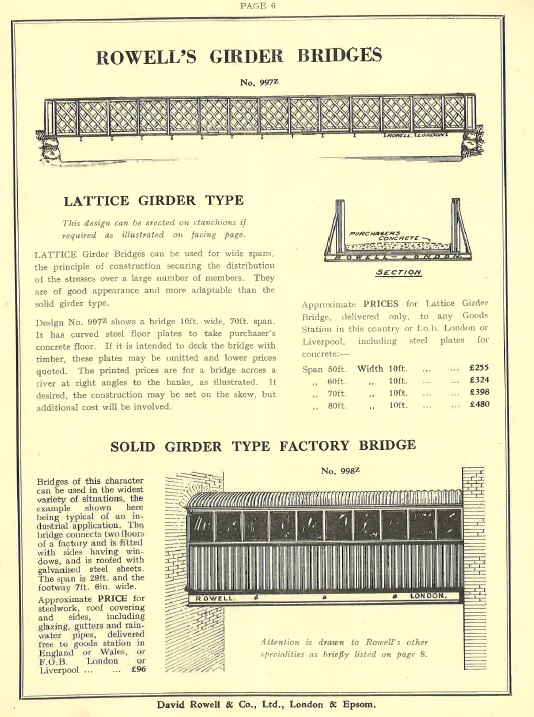
Works Begin, February 1927:
In his 3 February 1927 report, the City Engineer, Mr Stephen Farrington said he was notified by Messrs Rowell & Co that the steel erectors were coming over that week to start work on the suspension bridge at Ferry Walk.
In Late February 1927,the new suspension footbridge was rapidly nearing completion. The main structure of the bridge had been completed and the footway was almost completed. There yet remained to be done the painting of the entire structure and the erection of the railings to the approaches.
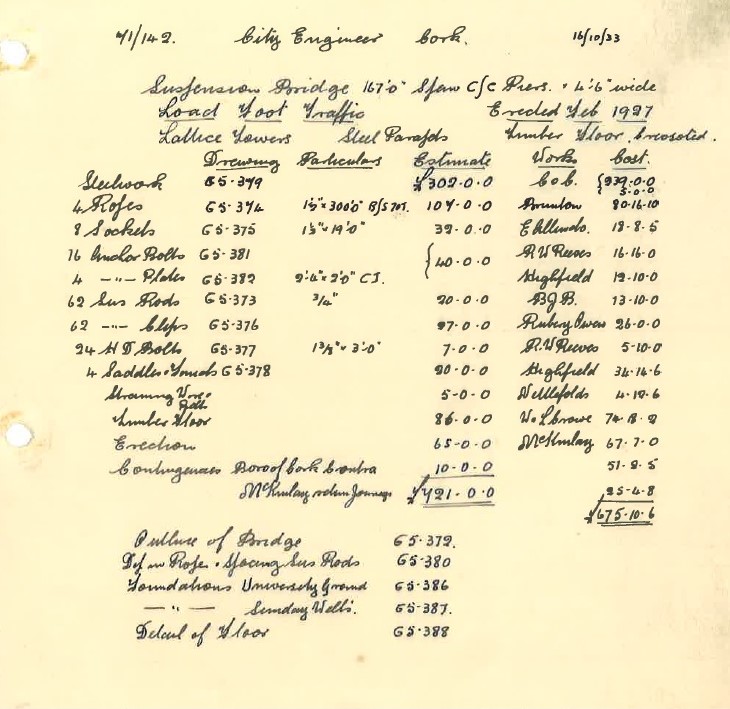
A Formal Opening, 9 April 1927:
The formal opening of Daly’s Bridge took place on Saturday 9 April 1927. Very Rev Canon O’Sullivan presided at the function. James Daly asked Sunday’s Well resident Mr M O’Driscoll, PC to open the bridge.
Mr O’Driscoll said that he felt that a very great honour had been conferred on him in asking him to formally open the bridge, which will do so much to “enhance the attractions of the district, and at the same time confer such as substantial benefit on the citizens in general, and on the residents of Sunday’s Well in particular”.
“Daly’s bridge would stand as a monument to the munificence of Mr James Daly, who made its erection possible to the public spirit of the city Commissioner, and to the technical and artistic ability of the City Engineer who designed it. I feel that in Mr Daly they had a citizen of whom they had every reason to be proud – without his moral and material financed support such an undertaking would not have been possible, and he would say without hesitation that were Cork possessed of but a few more citizens of his calibre it would be greatly to the advantage of the City by the Lee.
My only claim to the honour, which fell to his lot today was that he helped spade work, which overcame the initial difficulties on the project. I can truly say that, working with Mr Daly, this was a labour of love. His generosity and perseverance overcame all obstacles and for many years to come the citizens of Cork would have reason to feel grateful to him for his very beautiful to the amenities of the city. I formally declare Daly’s Bridge open to the public”.

Mr Philip Monahan, City Commissioner, said that it would not be right for the function to close without his saying on behalf of the citizens as a whole, that they were very grateful to Mr Daly for his great generosity and public spirit in giving such substantial financial assistance to the project;
“From the numbers who were anxious to cross since the first day the bridge was commenced I am sure that it would serve a very useful purpose for a great many years to come. My unfortunate function was to find out what the people of Cork wanted, and as far as possible to give it to them but it was very difficult to know when Cork people were serious or not! There was one infallible test—how much are those people who urge these projects ready to pay down?. That test was put to Mr. Daly, and he answered it magnificently. He was the only Corkman I have ever met to answer the test. I am not without hope that the example of Mr Daly would be followed by others”.
Mr James Daly said that it afforded him great pleasure to be with them at the opening of that beautiful bridge, and to listen to the flattering terms of which his action in the matter was spoken by the previous speakers;
“I have for many years endeavouring to get the bridge erected, so as to span the Lee at its most picturesque part and to supply a want for one of the most important and populous districts of the city and suburbs of Cork. There were a lot of obstacles in the wav, but with the assistance of the Committee, and others who saw clearly the great necessity of this bridge, they succeeded in clearing the way, and we have now the great pleasure of seeing the bridge completed and being opened to the public.
Since they put the case of this bridge before the able Commissioner (Mr Philip Monahan), he always treated them kindly and reasonably. The clever City Engineer (Mr F. W. Farrington), gave the project great assistance by submitting plans which were capable of being carried out at a very reasonable cost. Both Mr. Monahan and Mr Farrington deserved the best thanks of the citizens of Cork and the residents of those particular districts for the manner in which they carried out this very useful work. Their thanks were also due to the Very Rev. M. Canon O’Sullivan, Adm., and Rev. Doctor Rev. Jourdan for the great assistance which they rendered: also to Mr Stephen Farrington , Lord Cork’s agent, Mr. H. P. F. Donegan, solr.. and Mr. M. Driscoll, P.C., Sunday’s Well, for their active and ardent assistance.
All the steps that had been taken in the advancement of the project were but a source of joy to me. The accomplishment of their work had provided a most artistic structure, creating a much-needed thoroughfare for the service to the public and a benefit to posterity”.
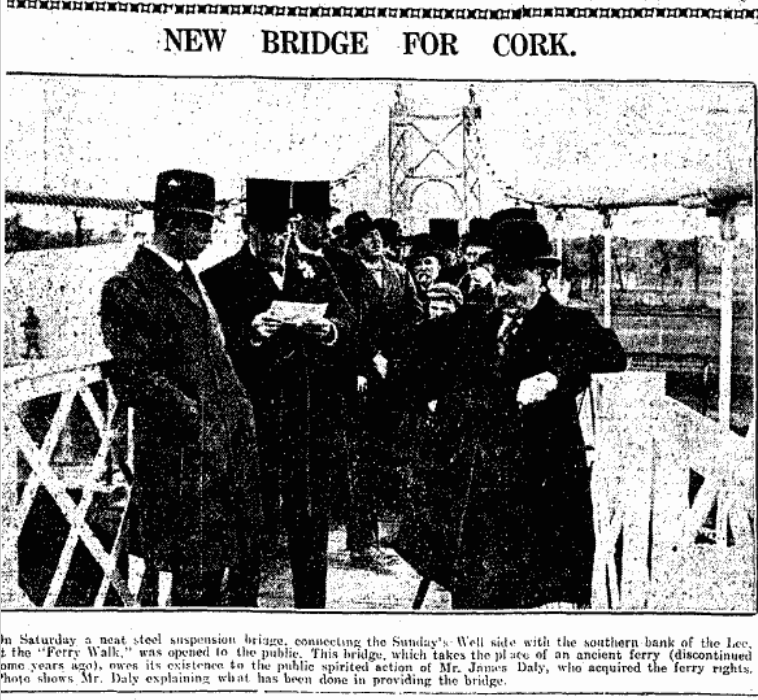
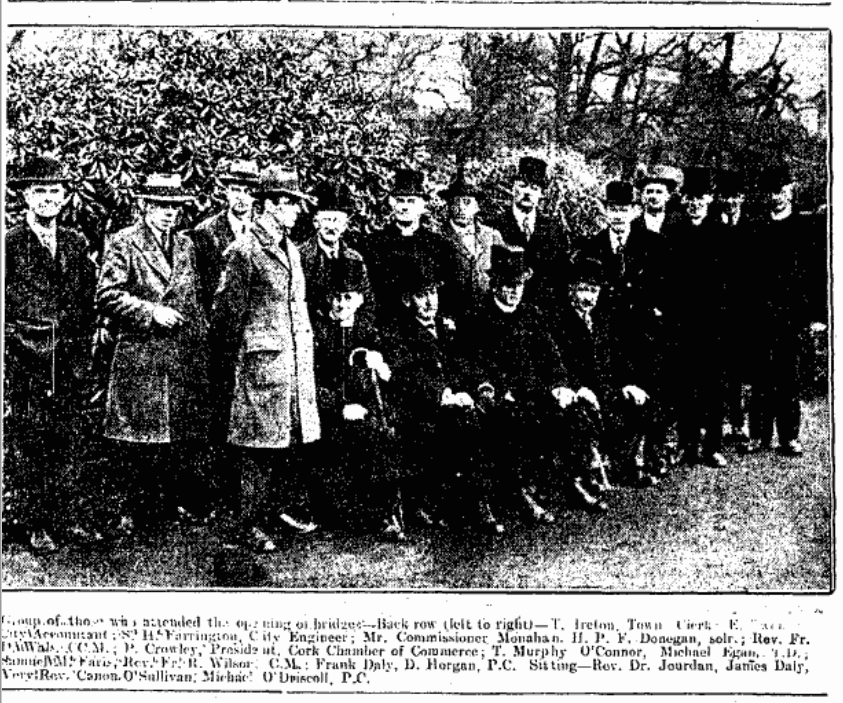
Daly’s Bridge in Context:
January 1927 – Roches Stores Building is completed (25th).
February 1927 – Blackrock Garda Station Re-opens (22nd).
March 1927 – First Proposal for Cork Industrial Fair (26th).
April 1927 – Cash and Co Building is completed.
April 1927 – Daly’s Bridge Opens (9th)
April 1927 – First youth pilgrimage of several hundred girls leaves Cork for Lourdes (14th)
April 1927 – The First Feis Maithiú Opens (18th)
April 1927 – New Wireless broadcasting station opens (26th)
April 1927 – Collection of tolls on City’s approach roads abolished (28th).
May 1927 – First set of Ex-Servicemen housing in (Ballinlough) Cork City given to tenants.
May 1927 – Dwyer’s Clothing Factory opens on Cornmarket Street (27th)
June 1927 – Former Lord Mayor and instigator of Cork International Exhibition, 1902, Sir Edward Fitzgerald Passes Away (22nd)
June 1927 – Plans and tenders for new Grand Parade Library completed (23rd)
July 1927 – Surveys begin for the erection of poles to carry electricity from Shannon to Cork (22nd).
August 1927 – Terro-concrete is poured between on Carrigrohane Straight to Victoria Cross.
September 1927 – Famous incident of a collision of a steam roller and the Muskerry Tram on Carrrigrohane Straight Road (6th).
September 1927 – M & P O’Sullivan open up a tobacco factory Red Abbey (29th).
October 1927 – Fire Brigade Captain Alfred Hutson retires after 36 ½ years service.
November 1927 – Tylers Footwear Store Opens. The last of the hoarding of the street is taken down from the Burning of Cork in December 1920 (3rd).
November 1927 – Omnibuses begin to run between major cities and town, provided by the Great Southern Railways (23rd)
November 1927 – Cork Corporation Houses at Capwell Road completed (16th).
November 1927 – Proposal for new entrance to UCC on Western Road presented to the public.
December 1927 – Cork Christmas Carnival Opens organised by the Cork Publicity Association (10th-24th December).
December 1927 – An Exhibition of the new Ford Model A is opened at Ford Works, Marina, Cork.
VIEW: A British Pathe film entitled “The New Cork. A trip through Patrick Street with its many fine buildings. Ireland”.
Renewal Project, 2012-2020:
An inspection report in 2012 highlighted corrosion to the bridge’s iron latticework, prompting calls for repairs. Those calls were repeated over the years, but funding was never secured.
The corrosion steadily worsened and the rust ate through several bars on the bridge’s railings, exposing dangerous gaps. The ironwork at key joints crumbled to the touch.
Works commenced on site in August 2019. Cork City Council appointed L&M Keating Ltd of Kilmihil, Co. Clare, as main contractor. In mid-September 2019 the main bridge structure was dismantled in four sections, as per originally assembled, and transported off-site to the workshop of Mackey Plant Construction Limited in Nenagh, Co. Tipperary.
In the period late September 2019 to January 2020 each of the four sections was extensively cleaned with all corrosion removed. All defective steelwork was sympathetically repaired with missing elements replaced.
In February 2020 the four sections were transported to Rossaveal in Co. Galway where a protective coating was applied to each section followed by layered repainting under factory conditions.Each of the four sections was returned to site and re-erected as per the dismantling process in reverse with the final section bolted into position on 16t March 2020.
During the same time period on site, the southern ramp was demolished and rebuilt. The four main suspension cables were removed and replaced. Both bridge towers were wrapped to prevent debris falling into the river, extensively cleaned with all corrosion removed.
Similar to the main bridge structure, all defective steelwork was sympathetically repaired with missing elements replaced followed by the application of a protective coating to each tower and layered repainting. On Friday 27 March 2020, the Government announced Public Health Measures to reduce the spread of the COVID-19 virus. Work on non-essential projects ceased and the Contractor closed the site at Daly’s Bridge.
Work subsequently recommenced on Monday 18 June 2020.Without prior notification, work ceased on site on 3 July 2020. L&M Keating Ltd. subsequently advised that they were unable to re-mobilise their supply chain to complete the remaining works.
Cork City Council separately engaged original sub-contractors who, working with staff from Cork City Council’s Operations Directorate, completed the remaining works. Cork CIty Council would like to express its thanks to these sub-contractors:
- Mackey Plant Construction Limited, Nenagh, Co. Tipperary.
- SSE Airtricity Utility Solutions, Little Island, Co. Cork.
- KNC Construction Ltd., Lehenaghmore, Cork
- Esemono Coating Services Ltd., Carraig na bhFear, Co. Cork.
11 October 2017, Cork’s iconic Shakey Bridge may be one ‘shake’ from collapse with Journalist Eoin English,
Cork’s iconic Shakey Bridge may be one ‘shake’ from collapse (irishexaminer.com)
29 July 2019, Work on repairing historic Shakey bridge set to begin with journalist Eoin English:
Work on repairing historic Shakey bridge set to begin (irishexaminer.com)
10 September 2019, Watch: Work to dismantle Cork’s iconic Shakey Bridge underway:
Watch: Work to dismantle Cork’s iconic Shakey Bridge underway (irishexaminer.com)
VIEW: Kieran’s Regeneration Journey, Daly’s Bridge, Cork, 2019-2020


